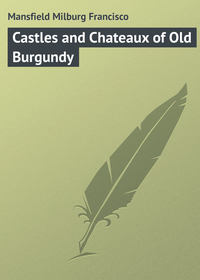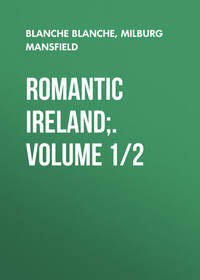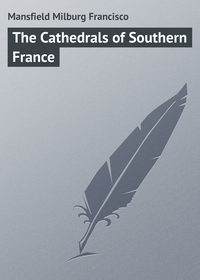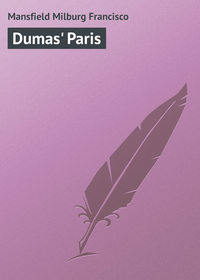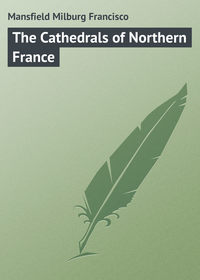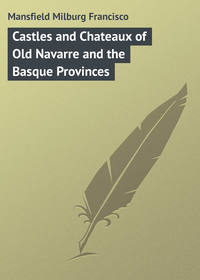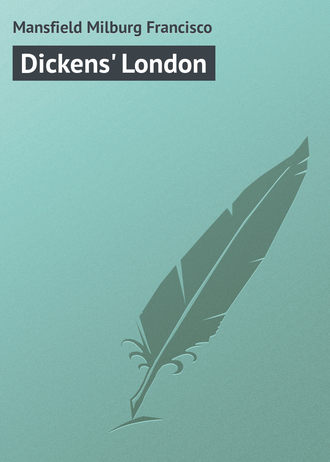 полная версия
полная версияDickens' London
At the corner of Bouverie Street are the Punch offices, to which mirthful publication Dickens made but one contribution, – and that was never published. Further adown the street is still the building which gave shelter to the famous dinners of the round-table when all the wits of Punch met and dined together, frequently during the London season.
In Mitre Court, until recently, stood the old tavern which had, in its palmier if not balmier days, been frequently the meeting-place of Johnson, Goldsmith, and Boswell; while but a short distance away we are well within the confines of the Temple which not only sheltered and fostered the law, but literature as well.
An incident which shows Dickens' sympathy with the literary life of the day was in 1854, when the great-grandson of the man who has given so much to all ages of Englishmen, – De Foe, – was made happy with a relief of £2 a month. Dickens was (as might have been expected) amongst the most liberal subscribers to the little fund. If everybody who has derived delight from the perusal of "Robinson Crusoe" had but contributed a single farthing to his descendant, that descendant would become a wealthy man. When De Foe was asked what he knew of his great ancestor's writings, he answered (though doubtless without any intentional comment on his ancestor's reputation) that in his happier days he had several of De Foe's works; but that he never could keep a copy of "Robinson Crusoe;" "there were so many borrowers of the book in Hungerford Market alone." Charles Knight, the publisher and antiquarian, instituted the fund, and the money was raised by him chiefly among literary men.
The most sentimental and picturesque interest attaches itself to the extensive series of buildings on the south side of Fleet Street, familiarly known as the Temple. Here Goldsmith is buried beside the curious and interesting Temple Church. The other of the four great Inns of Court are Lincoln's Inn in Chancery Lane and Gray's Inn in Holborn. Allied with the four great inns were the more or less subsidiary Inns of Chancery, all situated in the immediate neighbourhood, one of which, at least, being intimately associated with Dickens' life in London – Furnival's Inn, which, with Thavie's Inn, was attached to Lincoln's Inn. Here Dickens lived in 1835 at No. 15, and here also he lived subsequent to his marriage with Catherine Hogarth in the following year. It was at this time that the first number of "Pickwick" was written and published. The building itself was pulled down sometime during the past few years.
Comprising several squares and rows, what is commonly referred to as the Temple, belongs to the members of two societies, the Inner and Middle Temple, consisting of "benchers," barristers, and students. This famous old place, taken in its completeness, was, in 1184, the metropolitan residence of the Knights Templars, who held it until their downfall in 1313; soon afterward it was occupied by students of the law; and in 1608 James I. presented the entire group of structures to the "benchers" of the two societies, who have ever since been the absolute owners. The entrance to Inner Temple, from Fleet Street, is nothing more than a mere gateway; the entrance to Middle Temple is more pretentious, and was designed by Sir Christopher Wren.
Here in the heart of the great world of London exists, as in no other city on the globe, a quiet and leafy suburb, peopled only by those whose vocation is not of the commonalty. Its very environment is inspiring to great thoughts and deeds, and small wonder it is that so many master minds have first received their stimulus amid the shady walks and rather gloomy buildings of the Temple.
True it is that they are gloomy, on the outside at least, – dull brick rows with gravelled or flagged courtyards, but possessing withal a geniality which many more glaring and modern surroundings utterly lack.
The stranger, for sightseeing, and the general public, to take advantage of a short cut to the river, throng its walks during the busy hours around noontime. All sorts and conditions of men hurry busily along in a never-ending stream, but most to be remarked is the staid and earnest jurist, his managing clerk, or the aspiring bencher, as his duties compel him to traverse this truly hallowed ground.
By nightfall the atmosphere and associations of the entire Temple take on, if possible, a more quiet and somnolescent air than by day. It must, if report be true, be like a long-deserted city in the small hours of the night. A group of chambers, called rather contemptuously Paper Buildings, is near the river and is a good example of revived Elizabethan architecture. A new Inner Temple Hall was formally opened in 1870, by the Princess Louise. In October, 1861, when the Prince of Wales was elected a bencher of the Middle Temple, the new Library was formally opened. The Temple Church, as seen from the river, with its circular termination, like nothing else in the world except Charlemagne's church at Aix la Chapelle, is one of the most interesting churches in London. All the main parts of the structure are as old as the time of the Knights Templars; but restorations of the middle nineteenth century, when the munificent sum of £70,000 was spent, are in no small way responsible for its many visible attributes which previously had sadly fallen to decay. There are two portions, the Round Church and the Choir, the one nearly 700 years old and the other more than 600. The chief distinguishing features of the interior are the monumental effigies, the original sculptured heads in the Round Church, the triforium, and the fittings of the Choir. The north side of the church has been opened out by the removal of the adjoining buildings where, in the churchyard, is the grave of Oliver Goldsmith, who died in chambers (since pulled down) in Brick Court. The Temple Gardens, fronting the river, are laid out as extensive shrub and tree-bordered lawns, which are generously thrown open to the public in the summer. A more charming sylvan retreat, there is not in any city in the world.
In the good old times, legal education and hospitality went hand in hand, and the halls of the different Inns of Court were, for several centuries, a kind of university for the education of advocates, subject to this arrangement. The benchers and readers, being the superiors of each house, occupied, on public occasions of ceremony, the upper end of the hall, which was raised on a daïs, and separated from the rest of the building by a bar. The next in degree were the utter barristers, who, after they had attained a certain standing, were called from the body of the hall to the bar (that is, to the first place outside the bar), for the purpose of taking a principal part in the mootings or exercises of the house; and hence they probably derived the name of utter or outer barristers. The other members of the inn, consisting of students of the law under the degree of utter barristers, took their places nearer to the centre of the hall, and farther from the bar, and, from this manner of distribution, appear to have been called inner barristers. The distinction between utter and inner barristers is, at the present day, wholly abolished; the former being called barristers generally, and the latter falling under the denomination of students; but the phrase "called to the bar" still holds and is recognized throughout the English-speaking world.
The general rule, as to qualification, in all the Inns of Court, is, that a person, in order to entitle himself to be called to the bar, must be twenty-one years of age, have kept twelve terms, and have been for five, or three years, at least, a member of the society. The keeping of terms includes dining a certain number of times in the hall, and hence the pleasantry of eating the way to the bar; the preparatory studies being now private. Of the great business of refection, the engraving herewith shows the most dignified scene – the Benchers' Dinner; the benchers, or "antients," as they were formerly called, being the governors of the inn, at the Temple called the Parliament. The Middle Temple hall surpasses the halls of the other societies in size and splendour. Begun in 1562, and finished about ten years afterward, it is 100 feet long, 40 feet wide, and upwards of 60 feet in height. The roof and panels are finely decorated, and the screen at the lower end is beautifully carved. There are a few good pictures: amongst others, one of Charles I. on horseback, by Vandyke; also portraits of Charles II., Queen Anne, George I., and George II.
Lincoln's Inn was once the property of Henry De Lacy, Earl of Lincoln. It became an Inn of Court in 1310. The New Hall and Library, a handsome structure after the Tudor style, was opened in 1845. The Chapel was built in 1621-23, by Inigo Jones, who laid out the large garden in Lincoln's Inn Fields, close by, in 1620. Lord William Russell was beheaded here in 1683. In Lincoln's Inn are the Chancery and Equity Courts. Lincoln's Inn vied with the Temple in the masques and revels of the time of James I.
Gray's Inn, nearly opposite the north end of Chancery Lane, once belonged to the Lords Gray of Wilton. Most of its buildings – except its hall, with its black oak roof – are of comparatively modern date. In Gray's Inn lived the great Lord Bacon, a tree planted by whom, in the quaint old garden of the Inn, could, in Dickens' time, yet be seen – propped up by iron stays. To-day a diligent search and inquiry does not indicate its whereabouts, which is another manifestation of the rapidity of the age in which we live.
The nine Inns of Chancery allied with the four Inns of Court, the Inner and Middle Temple, Lincoln's Inn and Gray's Inn, are Clifford's Inn, Clement's Inn, Lyons' Inn, New Inn, Furnival's Inn, Thavie's Inn, Sergeant's Inn, Staple Inn, and Barnard's Inn, all of which were standing in Dickens' day, but of which only Staple Inn and Sergeant's Inn have endured, Clement's Inn having only recently (1903) succumbed to the house-breaker.
Staple Inn, in Holborn, "the fayrest inne of Chancerie," is one of the quaintest, quietest, and most interesting corners of mediæval London left to us.
Nathaniel Hawthorne, describing his first wanderings in London, said, "I went astray in Holborn through an arched entrance over which was Staple Inn, and here likewise seemed to be offices; but in a court opening inwards from this, there was a surrounding seclusion of quiet dwelling-houses, with beautiful green shrubbery and grass-plots in the court and a great many sunflowers in full bloom. The windows were open, it was a lovely summer afternoon, and I had a sense that bees were humming in the court." Many more years have passed over the old corner since Hawthorne's visit, but still it retains its ancient charm, and still the visitor is struck by the rapid change from the hurrying stream of Holborn's traffic to this haunt of ancient peace about which Mr. Worsfold writes with pardonable enthusiasm.
With a history traceable backward for many centuries, Staple Inn was at first associated in the middle ages with the dealing in the "staple commodity" of wool, to use Lord Chief Justice Coke's words, but about the fifteenth century the wool merchants gave way to the wearers of woollen "stuff," and their old haunt became one of the Inns of Chancery – the Staple Inn of the lawyers – perpetuating its origin in its insignia, a bale of wool. For many years the connection of the Inn with the Law was little beyond a nominal one, and in 1884 the great change came, and the haunt of merchants, the old educational establishment for lawyers, passed from the hands of "The Principal, Ancients and Juniors of the Honourable Society of Staple Inn," to those of a big insurance society, while the fine old hall became the headquarters of the Institute of Actuaries.
True it is, that perhaps no area of the earth's surface, of say a mile square, has a tithe of the varied literary association of the neighbourhood lying in the immediate vicinity of the Temple, the birthplace of Lamb, the home of Fielding, and the grave of Goldsmith.
Shoe Lane, Fleet Street, is still haunted by the memory of the boy Chatterton, and Will's Coffee House, the resort of wits and literary lights of former days, vies with Royal Palaces as an attraction for those who would worship at the shrines of a bygone age, – a process which has been made the easier of late, now that the paternal Society of Arts has taken upon itself to appropriately mark, by means of a memorial tablet, many of these localities, of which all mention is often omitted from the guide-books. Often the actual houses themselves have disappeared, and it may be questioned if it were not better that in some instances a tablet commemorating a home or haunt of some notability were not omitted. Still if the accompanying inscription is only sufficiently explicit, the act is a worthy one, and truth to tell, a work that is well performed in London.
Suburban London, too, in a way, may well come within the scope of the passion of any lover of material things which have at one time or another been a part and parcel of the lives of great men. And so, coupled with literary associations, we have the more or less imaginary "Bell" at Edmonton to remind us of Cowper, of many houses and scenes identified with Carlyle, at Chelsea; of the poet Thompson, of Gainsborough, and a round score of celebrities who have been closely identified with Richmond, – and yet others as great, reminiscent of Pepys, Addison, Steele, Thackeray and the whole noble band of chroniclers, essayists, and diarists of the seventeenth, eighteenth and nineteenth centuries.
The "houses of entertainment" – as the Georgian novelist was pleased to refer to inns and taverns – had in Dickens' day not departed greatly from their original status. Referring solely to those coaching and posting-houses situated at a greater or lesser distance from the centre of town, – on the main roads running therefrom, and those city establishments comprehended strictly under the head of taverns, – which were more particularly places of refreshment for mankind of the genus male. These two classes were, and are, quite distinct from the later-day caravanserai known as hotels, and as such performed vastly different functions.
To be sure, all life and movement of the early nineteenth century, and for a couple of hundred years before, had a great deal to do with inns and taverns.
From Chaucer's famous "Tabard," where —
"In Southwark at the Tabard as I layReady to wenden on my pilgrimage,"to "The Bull," at Rochester, whose courtyard is still as described by Dickens, and the somewhat mythical "Maypole" of "Barnaby Rudge," is a far cry, though it would appear that the kind of cheer and accommodation varies to a much lesser degree than might be supposed. Certainly the demand for brevity and the luxuriousness of the later years of the nineteenth century, and even to some extent during Dickens' time, with the innovation of railway travel, gas-lamps, the telegraph, and what not, was making an entirely new set of conditions and demands.
The old "Tabard" of Chaucer's day is no more, though an antiquary of 1840 has attempted to construct what it may have been out of the "Talbot" of that day, which stood in the ancient High Street of Southwark, just across London Bridge, where, said the annalist Stow, "there were so many fair inns for receipt of travellers," – the rivals of the Boar's Heads and Mermaids of another generation.
Of the actual Dickens' inns, perhaps none is more vividly impressed on the imagination than that of the "Maypole," that fantastic structure of "Barnaby Rudge," the original of which is the "King's Head" at Chigwell on the borders of Epping Forest. It was here that Mr. Willet sat in his accustomed place, "his eyes on the eternal boiler." "Before he had got his ideas into focus, he had stared at the plebeian utensil quite twenty minutes," – all of which indicates the minutiæ and precision of Dickens' observations. This actual copper, vouched for by several documents of attestation, with an old chair which formerly stood in the Chester Room of the "Maypole," is to-day in the possession of Mr. Bransby Williams, of London, an ardent enthusiast of all matters in connection with Dickens and his stories.
Of the Pickwickian Inns, the "White Horse" at Ipswich – "the overgrown tavern" to which Mr. Pickwick journeyed by the London Coach – is something of tangible reality, and doubtless little changed to this day; the same being equally true of "The Leather Bottle" at Cobham. The old "White Hart" in the Borough High Street, the scene of the first meeting of Mr. Pickwick and Weller, was demolished in 1889. Not so the "Magpie and Stump," – that referred to in "Pickwick" as being in the vicinity of the Clare Market, and "closely approximating to the back of the 'New Inn.'" This seems to have been of an imaginary character in nomenclature, at least, though it is like enough that some neighbourhood hostelry – or, as it is further referred to, as being what the ordinary person would call a "low public-house" – was in mind.
The old "Fountain Inn" of the Minories, referred to in "Oliver Twist," and the "little inn" ("The Sun") at Canterbury, where the Micawbers lodged, and the "White Hart" at Hook, – or more probably its predecessor of the same name, – visited by the Pickwickians en route to Rochester, – were realities in every sense of the word, and show once again the blending of truth and fiction which was so remarkable in the novels, and which indicates so strongly the tendency of Dickens to make every possible use of accessories, sights, and scenes, with which, at one time or another, he had been acquainted.
The "Saracen's Head" at Snow Hill, – a real thing in Dickens' day, – where the impetuous Squeers put up during his visits to London, has disappeared. It was pulled down when the Holborn Viaduct was built in 1869, and the existing house of the same name in no way merits the genial regard which is often bestowed upon it, in that it is but an ordinary London "Pub" which does not even occupy the same site as its predecessor.
"The Spaniards," where foregathered the No-Popery rioters, on Hampstead Heath, remains much as of yore; certainly it has not changed to any noticeable degree since Mrs. Bardell, et als., repaired hither in the Hampstead stage for their celebrated tea-party, as recounted in "Pickwick."
The very term Pickwickian Inns inspires rumination and imagination to a high degree. Remembrance is all very well, but there is a sturdy reality about most of the inns of which Dickens wrote. Thus the enthusiast may, if he so wish, in some cases, become a partaker of the same sort of comfort as did Dickens in his own time, or at least, amid the same surroundings; though it is to be feared that New Zealand mutton and Argentine beef have usurped the place in the larder formerly occupied by the "primest Scotch" and the juiciest "Southdown."
It is said there are twenty-five inns mentioned in "Pickwick" alone; the writer has never been able to count up but twenty-two: still the assertion may be correct; he leaves it to the curious to verify. Certainly such well revered names as the "Golden Cross," "The Bull," at Rochester, which, above all other localities drawn in "Pickwick," has the liveliest associations, "The Leather Bottle," "The Magpie and Stump," "The Marquis of Granby," "The Blue Boar," "The White Horse Cellars" in Piccadilly, and "The Great White Horse" at Ipswich are for ever branded upon the memory. The following half-dozen will perhaps be best recalled: "The Old White Hart" in the Borough High Street; "The George and Vulture," Mr. Pickwick's own favourite; "The Golden Cross," reminiscent of Dickens' own personality as well; "The White Horse Cellars," the starting-place of the Ipswich Coach; "Osborne's Hotel" in the Adelphi, still occupied as a rather shabby sort of hostelry, though the name has gone; "Jack Straw's Castle," where "Boz" and his friend Forster so often enjoyed that "shoemaker's holiday;" and lastly, "The Spaniards" at Hampstead. A description of one, as it is to-day, must suffice here.
"The Golden Cross," which stands opposite Charing Cross Railway Station, with its floriated gilt crosses usually brightly burnished, and the entire edifice resplendent in new paint.
There is still, however, something of the air of the conservatism of a former day, if only in the manner of building, which in the present case furthers the suggestion that the ways of the modern architect – striving for new and wonderful constructive methods – were unknown when the walls of this old hostelry were put up.
Its courtyard has disappeared, or rather has been incorporated into a sort of warehouse or stable for a parcels delivery company, and the neighbourhood round about has somewhat changed since the days of "Copperfield" and "Pickwick." The Charing Cross Railway Station has come upon the scene, replacing old Hungerford Market, and palatial hotels have been built where the gardens of Northumberland House once were. St. – Martin's-in-the-Fields is still in its wonted place, but with a change for the worse, in that the platform with its ascending steps has been curtailed during a recent alleged improvement in the roadway in St. Martin's Lane.
The National Gallery remains as of yore, except that it has recently been isolated by pulling down some adjoining structures to the northwest, as a precautionary measure against fire.
The Nelson Monument in Trafalgar Square, then newly arrived, is as it was in the days of Dickens' early life. But there is little suggestion in the hotel or its surroundings of its ever having been a "mouldy sort of an establishment in a close neighbourhood," and it is hard to believe that Copperfield's bedroom "smelt like a hackney-coach and was shut up like a family vault."
DICKENS' LITERARY LIFE
A brief account is here given of Dickens' literary career, which presents chronologically a review of his productions as they appeared.
The first of his literary efforts was the tragedy of "The Sultan of India," written in his precocious school-days at Chatham, when, if we except his Parliamentary journalistic work, nothing else was put forth until "The Dinner at Poplar Walk" was published in the Monthly Magazine (1833). The original "Sketches by Boz" – the first of which bore no signature – also followed in the Monthly Magazine. Other sketches under the same generic title also appeared in the Evening Chronicle, and yet others, under the title of "Scenes and Characters," were published in "Bell's Life in London" and the "Library of Fiction."
In 1836 a number of these fugitive pieces were collected into a volume, the copyright of which was sold to one Macrone for £100, who published them under the first and best known title, "Sketches by Boz." The familiar story of "Pickwick," its early conception and its final publication, is well known. Its first publication (in parts) dated from 1836-37. About this time Dickens had another bad attack of stage-fever, and wrote a farce, "The Strange Gentleman," the libretto of an opera called "The Village Coquettes," and a comedy, "Is She His Wife?" more particularly perhaps for amateur representation, in which he was very fond of taking part. "Oliver Twist," a courageous attack on the Poor Laws and Bumbledom, followed in 1838, though it was not completed until after "Nicholas Nickleby" began to appear in 1839.
At this time was started Master Humphrey's Clock, a sort of miscellany in which it was intended to publish a series of papers written chiefly by Dickens himself after the style of Addison's Spectator of a former day. It was not at first successful, and only upon the commencement therein of the "Old Curiosity Shop" did it take on in any sense.
Master Humphrey's Clock ran down with the completion of the novel, though this story, in company with "Barnaby Rudge," a tale of the riots of '80, was not issued in book form until 1848 and 1849.
The authorship of "Pickwick" was unknown by the great mass of the public until very nearly the completion of the work in serial parts. Much conjecture was raised, and a writer in Bentley's Miscellany published the following lines under the title of:
IMPROMPTU"Who the Dickens 'Boz' could bePuzzled many a learned elf,Till time revealed the mystery,And 'Boz' appeared as Dickens' self."The other contributions made by Dickens to this periodical were afterward added to his published works under the title of "Master Humphrey's Clock."






